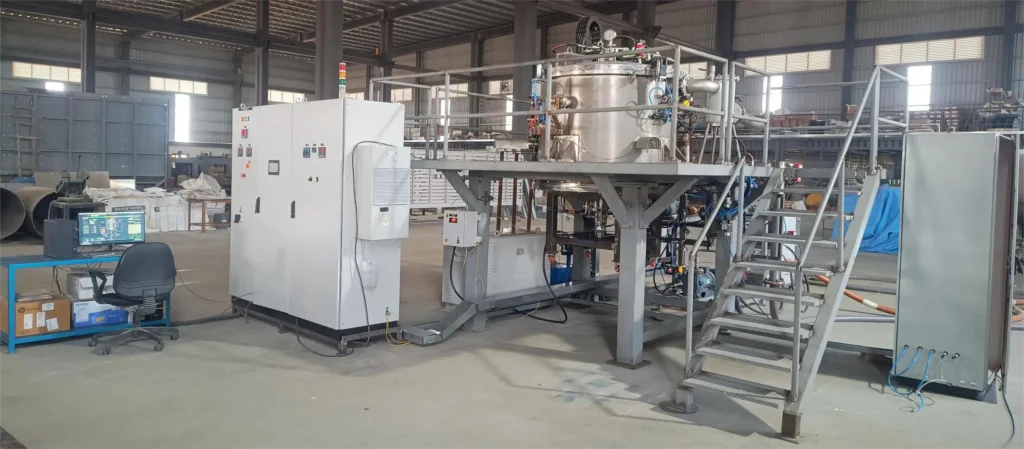Bottom Loading / Vertical Vacuum Furnace by Therelek

Power consumption is found to be comparatively lower in case of the vacuum furnace, than that of the salt bath furnace. The latest and advanced technology of vacuum furnace heating chamber comes from some really high-quality insulation materials and barriers, that locks the electric heating energy in the heating room itself.
Vacuum heat treatment is the combination of vacuum technology and heat treatment, where the entire heat treatment process is processed under vacuum. Currently, the working vacuum of most vacuum heat treatment furnaces is 1.33~1.33×10ˉ3Pa.
Basic pre-requisites of the vacuum furnace:
1. Normal temperature limit: 0.0667Pa, 0.000667Pa
2. Furnace size: Φ80 ~ 320 × Φ150 ~ 400 (mm)
3. Highest furnace temperature: 1000 ° C ~ 2000 ° C
4. Heating power :20~200kW
The vacuum heat furnaces work under negative pressure. The quenching gas used is also an inert gas, which will not cause an explosion phenomenon, which provides a great guarantee for the safety of the operators.
The steel plates found in the heating chamber of vacuum heat furnaces are of extreme heat-resistant steel sheets, and the heat resistance is much higher than the working limit temperature.
Even the pressure of these steel plates used in the furnace body of the gas quenching furnace also happens to be much higher than the working limit pressure, thus ensuring a completely safe and sound usage of the vacuum furnace, thereby increasing the service life of the vacuum furnace.
The way the vacuum heat furnace is designed, calls for optimum practicality and compact usage of space. The oil pool of the oil quenching furnace is kept below the furnace body that actually saves the production space.
The heating process of the vacuum furnace happens in all enclosed space and applied to quite a huge extent. This makes sure that there is minimum heat loss and the uniformity of the furnace temperature is controllable and reached in no time.
The recyclable cooling water in the water makes sure there is zero water wastage or pollution during the entire procedure.
There are copper-copper heat exchangers in the furnace body, lowers down the temperature of the gas during the gas quenching, and hence gives a better convenient cooling effect. The heat exchanger itself is rightly air-tight in nature, having zero direct contact with the furnace which cuts any contamination to the water.
The vertical vacuum furnace system takes up only a small area and hence saves much space for the plant. If this wasn’t enough, one may have a temporary storage for the load under a vertical vacuum heat treatment furnace and later on ascended as per convenience.
Vertical vacuum heat treatment furnaces predominantly apply to heat treatment components that have cylindrical cross sections or parts that can be stacked vertically as found in the aerospace industry.
These furnaces carries out temperature measurements even in hard-to-reach areas. Due to great configuration, one may trace thermocouple sensors anywhere in the whole furnace.
Features & Specifications
| TITLE | DESCRIPTION |
|---|---|
| Furnace Type | Cold Wall (top loading or bottom loading) |
| Hot Zone | Cylindrical/Cubical |
| Temperature Range | 800°C to 2200°C (furnace) |
| Vacuum | 10-2m.bar to 10-6 m.bar |
| Vacuum System | Rotary-Roots combination/Diffusion pump/Turbo Molecular pump |
| Heating Elements | Molybdenum/Tungsten/Graphite |
| Gas Quench | Up to 5 bar, optionally 10 bar |
| Instrumentation options | Thyristor, Programmable |
- Furnace Type: Cold Wall (top loading or bottom loading)
- Hot Zone: Cylindrical/Cubical
- Temperature Range: 800°C to 2200°C (furnace)
- Vacuum: 10-2m.bar to 10-6 m.bar
- Vacuum System: Rotary-Roots combination/Diffusion pump/Turbo Molecular pump
- Heating Elements: Molybdenum/Tungsten/Graphite
- Gas Quench: Up to 5 bar, optionally 10 bar
- Instrumentation options: Thyristor, Programmable
Gallery
More about Bottom Loading Furnace
» Annealing
» Isothermal Annealing
» Stress Relieving
» Hardening
» Tempering
» Sintering
» Brazing
» Normalizing
» Case Hardening
» Laboratory Applications
» Cleanliness
» Repeatability
» Reliability
» Excellent process parameters and temperature uniformity
» Bright oxide-free treatment of most metals and alloys
» Safe operation
» Easy maintenance
» Removal of surface volatile
- Applications
- Advantages
» Annealing
» Isothermal Annealing
» Stress Relieving
» Hardening
» Tempering
» Sintering
» Brazing
» Normalizing
» Case Hardening
» Laboratory Applications
» Cleanliness
» Repeatability
» Reliability
» Excellent process parameters and temperature uniformity
» Bright oxide-free treatment of most metals and alloys
» Safe operation
» Easy maintenance
» Removal of surface volatile
